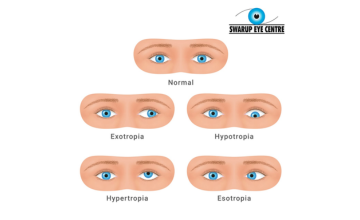- Email: info@swarupeye.com
- Hyderabad
- Call: +918886309030
Mon-Sat 09:00AM-07:00PM
Squint
Squint (Strabismus)
At Swarup Eye Centre, we recognize the impact that squint, also known as strabismus, can have on both vision and self-esteem. Our team of experienced ophthalmologists is dedicated to providing comprehensive diagnosis and treatment for this common eye condition.

What is Squint?
Squint, or strabismus, is a condition where a person’s eyes do not align properly and look in different directions. It can affect one or both eyes and is mostly seen in children but can also occur in adults.
Causes of Squint
In Children:
- Refractive Errors: Conditions like hyperopia, myopia, and astigmatism can cause eye strain, leading to misalignment.
- Muscle Imbalance: Improper coordination of eye muscles may cause one eye to deviate.
- Genetic Factors: Family history of strabismus increases the risk.
- Medical Conditions: Conditions like Down syndrome, cerebral palsy, or developmental delays can contribute to squint.
- Congenital Squint: Some babies are born with strabismus.
In Adults:
- Neurological Disorders: Stroke, head injuries, or nerve damage can affect eye movement.
- Thyroid Eye Disease: Graves' disease can impact the eye muscles.
- Diabetes: Uncontrolled diabetes may cause nerve damage affecting eye alignment.
- Myasthenia Gravis: A neuromuscular disorder that can cause muscle weakness in the eyes.
- Previous Childhood Strabismus: Sometimes, a childhood squint can return in adulthood.
- Trauma: Injury to the eye area can result in nerve or muscle damage leading to squint.
Symptoms of Squint
- Double vision.
- Closing or covering one eye when looking at something nearby.
- Tilting or turning the head.
- Headaches.
- Difficulty reading.
- Eye strain.
Types of Squint
- Esotropia: One eye turns inward (crossed eyes).
- Exotropia: One eye turns outward (wall-eyed).
- Hypertropia: One eye turns upward.
- Hypotropia: One eye turns downward.
Effects of Squint
- Can lead to amblyopia ("lazy eye"), reducing vision in the weaker eye.
- Impaired depth perception.
- May affect appearance and self-confidence.
Treatment Options
- Corrective Lenses: Glasses or contact lenses can correct refractive errors that contribute to squint.
- Eye Patching: Strengthens the weaker eye by forcing it to work harder, effective in children.
- Eye Exercises: Specific exercises improve eye muscle coordination.
- Strabismus Surgery: Adjusts eye muscles to realign the eyes, improving both vision and appearance.
Why Choose Swarup Eye Centre?
- Expert Team: Highly skilled ophthalmologists specializing in squint treatment.
- Advanced Diagnostics: State-of-the-art technology for precise diagnosis.
- Personalized Treatment Plans: Tailored solutions for every patient, from children to adults.
Schedule a Consultation
Early intervention is key to preventing vision problems caused by squint. If you or your child show signs of squint, visit Swarup Eye Centre for expert evaluation and treatment.
